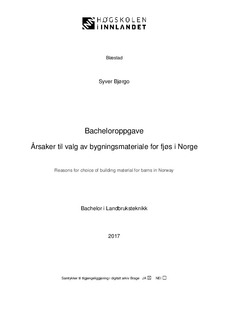| dc.contributor.author | Bjørgo, Syver | |
| dc.date.accessioned | 2017-06-28T11:07:26Z | |
| dc.date.available | 2017-06-28T11:07:26Z | |
| dc.date.issued | 2017 | |
| dc.identifier.uri | http://hdl.handle.net/11250/2447207 | |
| dc.description.abstract | Denne oppgaven har undersøkt årsaker til valg av bygningsmateriale for fjøs i Norge. Resultatene i oppgaven er fremstilt av en undersøkelse som ble sendt ut til bønder som hadde bygget nytt fjøs, bygd tilbygg eller gjort omfattende ombygging de siste fem årene. Undersøkelsen viste at geografisk plassering har en sammenheng med materialvalget. Materialer som tradisjonelt er mye brukt i Norge er fortsatt dominerende i de ulike geografiske områdene, og det er mest sannsynlig på grunn av vær og klimaforhold at vi ser disse geografiske forskjellene. Sør-Vestlandet bruker mest betong, stål og sandwich, mens Innlandet og Trøndelag er de største på bruken av tre. Akershus, Østfold og Buskerud bruker også mye treverk, men andelen betong er også stor. Muligheten for egeninnsats hadde størst betydning for de som valgte tre som hovedbyggemateriale i vegg- og takkonstruksjon. Forhold som produksjonstype, m2-pris, tidligere erfaring med brann, ombyggingsmulighetene, størrelsen på bygget, innredningsmaterialet, levetid, byggetid og renslighet i fjøset tydet ikke på å ha noen direkte innvirkning eller sammenheng med valget av materiale. Oppgaven viser også tydelig at det i overraskende mange byggeprosjekter av fjøs blir begått feil i planleggingen av bygget eller med hensyn til innpassing av bygget i den videre driften på gården, noe som gjør at resultatet ikke blir så godt som det kunne vært. Bøndene er likevel jevnt over godt fornøyd med den moderniseringen som byggeprosjektet har tilført gården. | nb_NO |
| dc.description.abstract | This bachelor thesis has prospected reasons for the choice of building material for barns in Norway. The results of this thesis are made out of a survey that was sent out to farmers who had built either a new barn, a supplement building or done extensive remodelling over the past five years. The survey showed that the geographic location has a coherence with the choice of material. The cause of this difference in choice of materials are probably in due to weather and climate conditions. Materials that are traditionally a lot used in Norway are still dominating in different parts of the country. The materials that are mostly used in the southwest part of Norway are concrete, steel and sandwich, while Innlandet and Trøndelag are those who use wood the most. Akershus, Østvold and Buskerud are also using a lot of wood, but concrete is used in large quantities too. Opportunities for individual effort had largest importance for those who chose wood as main material in construction of roofs and walls. Relations as type of production in the barn, m2- price, earlier experience with fire, the opportunities for rebuilding, the extent of the building, the material for furnishings, lifetime, the time of construction and cleanliness in the barn did not indicate to have a direct impact or coherence with the choice of material. Also, the thesis shows clearly that surprisingly many building projects of barns has defects in the planning process of the building or in the planning of future development at the farm. This makes the result not as good as it can be. The farmers are still generally pleased with the modernisation that the building project has contributed to the farm. | nb_NO |
| dc.language.iso | nob | nb_NO |
| dc.title | Årsaker til valg av bygningsmateriale for fjøs i Norge | nb_NO |
| dc.title.alternative | Reasons for choice of building material for barns in Norway | nb_NO |
| dc.type | Bachelor thesis | nb_NO |
| dc.subject.nsi | VDP::Landbruks- og Fiskerifag: 900::Landbruksfag: 910 | nb_NO |
